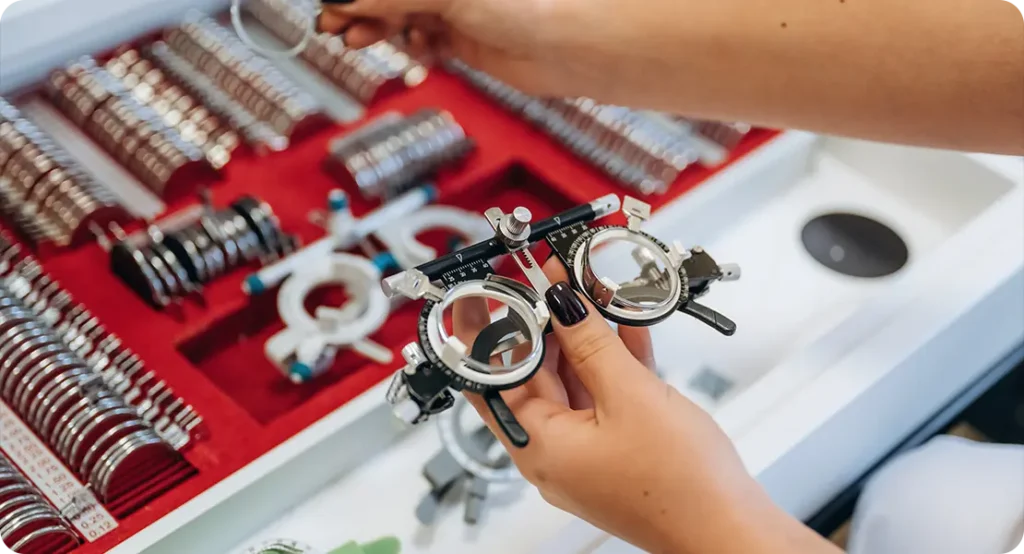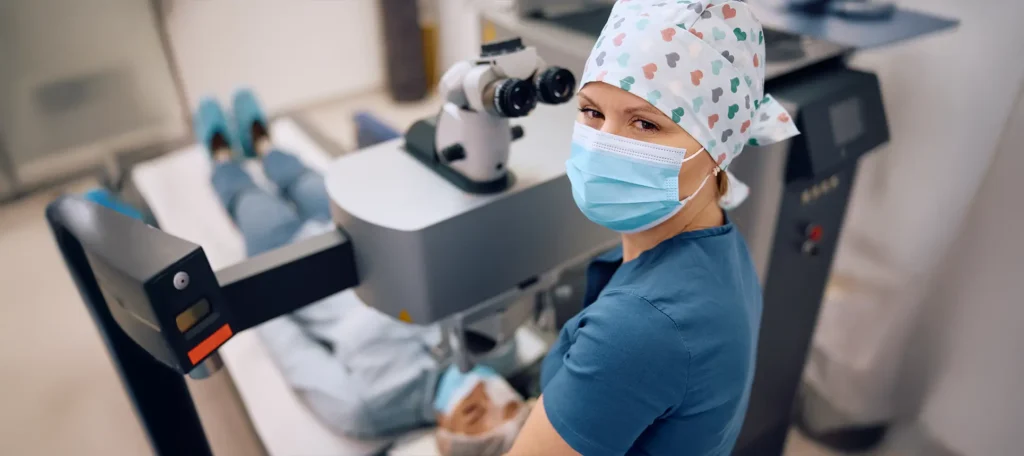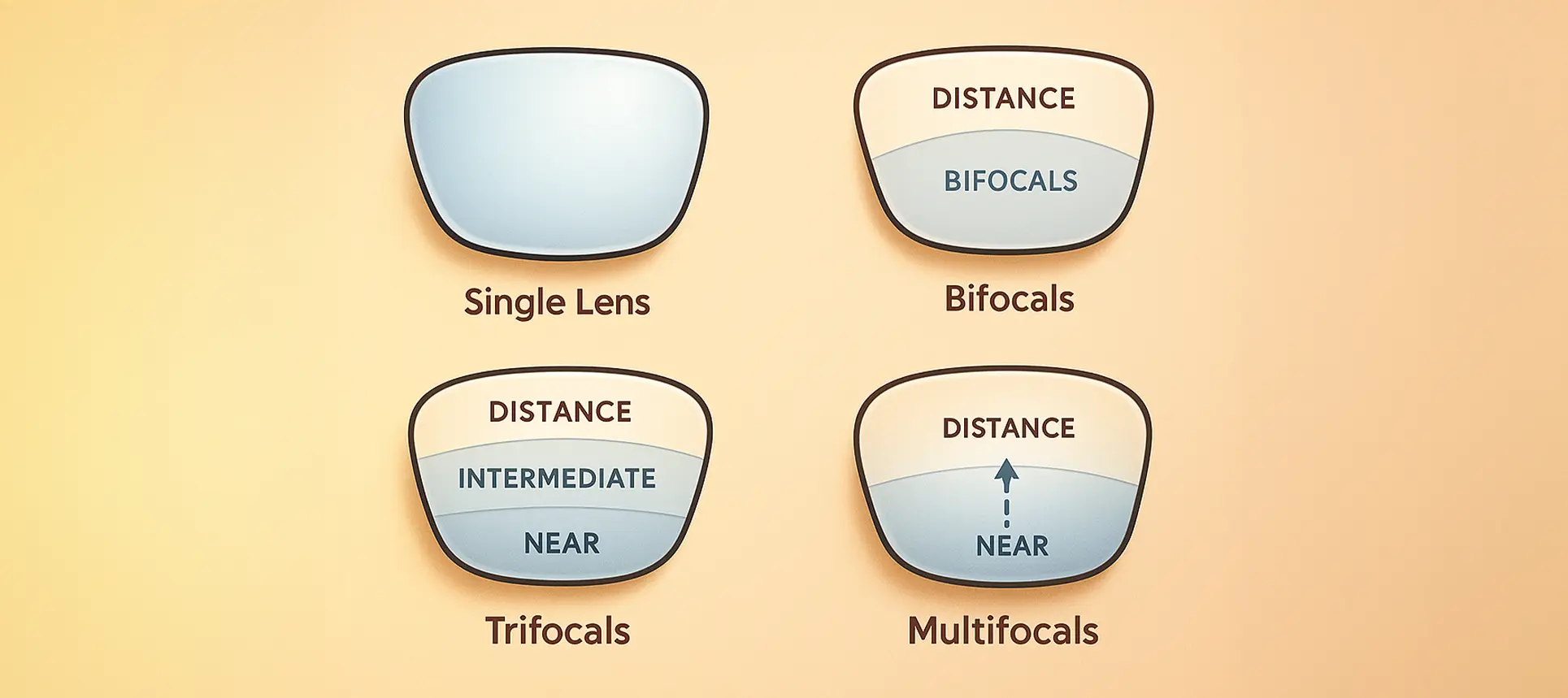1. What exactly are multifocal lenses?
Multifocal lenses are a type of intraocular lens (IOL) implanted during cataract surgery that helps restore vision at multiple distances—near, intermediate, and far. Unlike monofocal lenses, which focus on just one distance (usually far), multifocal IOLs are designed to reduce or even eliminate the need for glasses after surgery. These lenses use advanced optical designs—such as concentric rings or layered zones—to split incoming light and focus it at various distances.
If you’re used to wearing bifocals or varifocal glasses, you may already understand the concept behind these lenses. Multifocal IOLs aim to replicate this ability directly within your eye, giving you seamless vision across multiple ranges without needing to swap glasses or squint. This can be especially beneficial for people who live active lifestyles or frequently switch between reading and driving.
However, they’re not a one-size-fits-all solution. They do come with trade-offs, like potential glare or halos around lights at night. But for many patients, the increased freedom from spectacles far outweighs the adjustment period that comes with them. Your surgeon will help you decide whether they suit your visual needs and lifestyle.
2. Are multifocal lenses suitable for everyone?
Not necessarily. While many patients can benefit from multifocal lenses, they’re not right for everyone. Your suitability depends on several factors including the health of your eyes, your lifestyle needs, and how comfortable you are with potential side effects like glare or reduced contrast in low-light conditions.
If you have other eye issues—such as significant dry eye, macular degeneration, or diabetic retinopathy—then multifocal IOLs might not be recommended. That’s because these conditions can interfere with the way light is processed in your eye, making it harder for the brain to adapt to the optical design of multifocal lenses. In such cases, your surgeon might recommend alternative lenses such as toric or monofocal IOLs tailored to your needs.
That said, if you’re in good general eye health and you’re motivated to reduce your dependence on glasses, multifocal lenses can offer excellent results. A detailed eye examination and discussion with your cataract surgeon will help you weigh the pros and cons and choose the most appropriate solution for your eyes.
3. Will I still need glasses after getting multifocal lenses?
The goal of multifocal lenses is to minimise or eliminate your need for glasses, especially for daily activities like reading, working on a computer, or driving. Many patients report a high degree of freedom from spectacles after their surgery. However, it’s important to understand that no lens can guarantee complete spectacle independence for every individual.
Some people still find they need reading glasses for very fine print or prolonged close-up tasks. Others might use glasses in dim lighting or for specific visual tasks like sewing or precision work. This varies depending on how well your eyes adapt to the lenses and how demanding your visual lifestyle is.

If complete freedom from glasses is a high priority for you, it’s worth discussing this with your surgeon before the procedure. They might suggest blending different lens types between your two eyes (e.g., a multifocal in one and a monofocal in the other) to maximise visual outcomes for your specific needs.
4. How do multifocal lenses differ from monofocal lenses?
The main difference lies in the range of vision they offer. Monofocal lenses are designed to provide clear vision at just one set distance—typically for seeing far away. This means you’ll likely still need glasses for near tasks like reading or using your phone. On the other hand, multifocal lenses aim to provide functional vision at multiple distances, reducing or even eliminating your reliance on spectacles.
Multifocal lenses achieve this by using a series of rings or zones, each calibrated to focus light at different ranges. Your brain learns to select the most relevant image, depending on what you’re looking at. This can take a bit of getting used to, especially in the first few weeks after surgery, but most patients adapt well over time.
In short, monofocal lenses offer a more straightforward visual experience with fewer optical side effects, while multifocal lenses trade a bit of clarity in specific settings for the convenience of a glasses-free lifestyle. It’s all about what suits your personal vision goals best.
5. What are the potential downsides of multifocal lenses?
Multifocal lenses are innovative, but they’re not perfect. One of the most commonly reported issues is glare and halos around lights—especially at night. This can be noticeable when driving, for instance, where bright headlights may appear to have rings around them. These symptoms usually lessen over time, but in some cases, they may persist.
Another potential downside is reduced contrast sensitivity. This means it might be harder to distinguish between subtle shades in dim lighting, which can be an issue in settings like a darkened restaurant or a poorly lit room. While this isn’t dangerous for most people, it can be inconvenient if your work or hobbies rely on precise visual detail.
Finally, multifocal lenses are more expensive than monofocal options, and often aren’t fully covered by NHS treatment or basic insurance packages. So, if cost is a consideration, that’s something you’ll need to factor into your decision-making process.
6. Can multifocal lenses correct astigmatism?
Standard multifocal lenses are not designed to correct astigmatism directly. However, there are toric versions of multifocal lenses that can address both astigmatism and multiple focal points. These are known as toric multifocal lenses, and they combine the benefits of two technologies in one solution.
If you have astigmatism and you’re considering multifocal lenses, your cataract surgeon will usually recommend this toric variant. These lenses are specially shaped to counteract the uneven curvature of your cornea that causes astigmatism. This allows for clearer, sharper vision without the distortion that might otherwise occur.

It’s crucial that the toric component is aligned properly during surgery, as even a small misalignment can affect visual outcomes. Surgeons today use advanced tools and image-guidance systems to ensure precise placement and rotation of these lenses. With the right preparation and expertise, excellent results are absolutely possible.
7. How long does it take to adjust to multifocal lenses?
The adjustment period for multifocal lenses varies from person to person, but generally takes a few weeks to a few months. During this time, your brain is learning how to interpret the different light patterns being delivered by the lens. This process is known as neuroadaptation.
In the early days, you may notice halos around lights, or find it difficult to switch focus quickly between near and far objects. This is completely normal and usually improves over time as your brain becomes more accustomed to processing multiple focal zones. Some patients adapt almost immediately, while others require a bit more patience.
The key to success is to stick with it and give your brain the time it needs. Avoid switching between old glasses and your new vision during this period, as it can slow down the adaptation process. Regular follow-ups with your ophthalmologist will ensure you’re on the right track and help address any issues that come up during recovery.
8. Are there different types of multifocal lenses?
Yes, there are several types of multifocal lenses, each with slightly different designs and benefits. The two main categories are refractive multifocal lenses and diffractive multifocal lenses. Refractive lenses use concentric zones with varying refractive power, while diffractive lenses use stepped or ringed optics to split light into multiple focal points.
In addition to these, there are also extended depth-of-focus (EDOF) lenses, which aren’t technically multifocal but work similarly by elongating the focus rather than creating distinct focal points. This allows for smoother transitions between distances and can reduce the incidence of glare or halos, although they might not provide the same strength of near vision.
Some modern IOLs also blend technologies to offer a ‘hybrid’ approach, combining aspects of multifocal, toric, and EDOF designs. Your surgeon will choose the best option based on your lifestyle, eye health, and specific visual goals. There’s no one-size-fits-all answer, which is why a customised consultation is so important.
9. Do both eyes need to have multifocal lenses?
Not necessarily. While many patients do choose to have multifocal lenses in both eyes for balanced vision, it’s not the only option. In some cases, your surgeon may recommend a different lens in each eye—this is called “blended vision” or “mix and match.” For example, one eye might receive a multifocal lens for near and intermediate vision, and the other might get a monofocal lens optimised for distance.
This approach can help tailor the outcome to your specific daily activities. For instance, someone who spends a lot of time driving and only occasionally reads small print might benefit from a different setup than someone who does close-up work all day. The idea is to maximise your functional vision across different scenarios.

Of course, having two different lenses means your brain has to work a little harder to reconcile the visual input. Most people adapt quite well, but it may not be right for everyone. A thorough pre-operative assessment and a detailed discussion with your surgeon will help determine the most suitable arrangement.
10. How long do multifocal lenses last?
Multifocal intraocular lenses are designed to last a lifetime. They’re made from durable, medical-grade materials such as acrylic or silicone, which don’t degrade inside the eye. Once implanted, they don’t wear out or need to be replaced—unlike contact lenses or glasses.
That said, the eye itself can still undergo changes. One common post-surgical issue is posterior capsule opacification (PCO), which is sometimes referred to as a ‘secondary cataract.’ This is not a problem with the lens itself, but with the natural lens capsule that holds it. Fortunately, PCO can be quickly and painlessly treated with a YAG laser procedure.
So while the multifocal lens itself won’t need replacing, your overall eye health still needs monitoring. Regular eye exams ensure everything is working as expected and help catch any unrelated issues, such as glaucoma or macular degeneration, early on.
11. Can multifocal lenses be removed if I don’t like them?
While multifocal lenses are intended to be a permanent solution, it is technically possible to remove them if absolutely necessary. However, explanting an intraocular lens (IOL) is a much more complex procedure than the original cataract surgery. It carries additional risks, such as infection, damage to the eye’s structures, or even loss of vision in rare cases.
That’s why surgeons take great care in helping you choose the right lens in the first place. In cases where a multifocal lens really isn’t working—for example, if someone cannot tolerate severe glare or poor contrast sensitivity—a lens exchange may be considered. Some patients might opt to swap the multifocal lens for a monofocal one to achieve clearer, more straightforward vision at a single distance.
Thankfully, the number of people needing to have a multifocal lens removed is very small. Most patients adapt well with time, and many initial concerns—like glare—often improve naturally within the first few months after surgery.
12. How much do multifocal lenses cost?
The cost of multifocal lenses can vary widely depending on where you have your surgery, the type of lens selected, and whether the procedure is done privately or through the NHS (where multifocal lenses are typically not included). In the private sector, you can expect to pay somewhere between £3,000 and £5,000 per eye for cataract surgery with a multifocal lens.
This cost often includes consultations, measurements, the lens itself, surgery fees, and post-operative care. Some clinics offer payment plans to make the procedure more accessible, but it’s important to read the fine print and ensure you know what’s included. Additional procedures, like YAG laser treatment for posterior capsule opacification (if needed later), might be charged separately.

While it’s undoubtedly an investment, many patients feel that the benefits—especially the freedom from glasses and the improvement in quality of life—make the expense worthwhile. It’s always a good idea to have a detailed consultation and receive a written breakdown of all costs before committing.
13. Will I experience glare and halos forever?
Glare and halos are some of the most common side effects experienced by patients with multifocal lenses, particularly during the early months after surgery. Typically, these visual disturbances are most noticeable when looking at bright lights in a dark environment, such as car headlights when driving at night.
The good news is that for most people, these symptoms decrease significantly over time. This happens as your brain adapts and learns how to filter the light patterns produced by the multifocal optics. Within three to six months, many patients report that glare and halos are much less noticeable—or that they’re no longer bothered by them at all.
However, in a small minority of cases, these symptoms can persist long-term. If they remain troublesome even after the adjustment period, there are options to manage them, such as using anti-glare glasses at night or, in rare cases, considering lens exchange surgery. Honest conversations with your surgeon before surgery can help set realistic expectations.
14. Can I have multifocal lenses if I have had previous eye surgery?
Whether you can have multifocal lenses after previous eye surgery largely depends on the type of surgery you had and the current health of your eyes. For instance, if you’ve had LASIK or PRK laser vision correction in the past, you can still be a candidate for multifocal IOLs—but your surgeon will need to carry out more detailed measurements to ensure accurate lens power selection.
On the other hand, if you’ve had surgery for conditions like retinal detachment, glaucoma, or corneal transplants, the situation becomes more complex. These underlying conditions may affect the visual quality or stability of your eye, making multifocal lenses less predictable or even inadvisable.
Ultimately, a thorough pre-operative assessment will guide the decision. Modern diagnostic tools such as corneal topography, OCT scans, and specialised biometry help surgeons build a complete picture of your eye’s anatomy and determine whether multifocal lenses are a safe and effective choice for you.
15. How do I know if multifocal lenses are right for me?
Choosing a multifocal lens is a highly personal decision that hinges on your lifestyle, your visual priorities, and your willingness to adapt during the adjustment period. If being able to switch seamlessly between reading a book, working at a computer, and driving without reaching for glasses is important to you, multifocal lenses could be a fantastic option.
However, you also need to weigh the potential trade-offs, like glare and reduced contrast sensitivity, against the benefits. If you often drive at night, do detailed precision work, or have any underlying eye conditions, your surgeon might recommend a different type of lens or a tailored solution like monovision.
The best first step is to book a consultation with an experienced cataract surgeon who can assess your eye health, talk through your visual goals, and recommend a lens strategy customised to your needs. With the right advice and preparation, you can achieve a life-changing improvement in your vision.
Final Thoughts
Choosing multifocal lenses for cataracts is a big decision, but it’s one that can transform your day-to-day life if done carefully. By understanding the realities—both the incredible benefits and the potential challenges—you’ll be in the best position to make a choice you’re happy with. Remember: your journey to better vision is personal, and taking the time to get the right advice will pay off for years to come.

